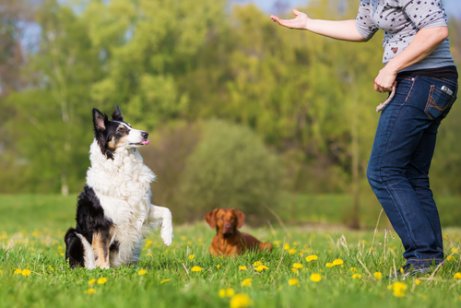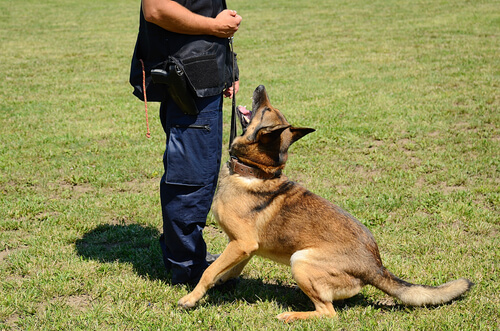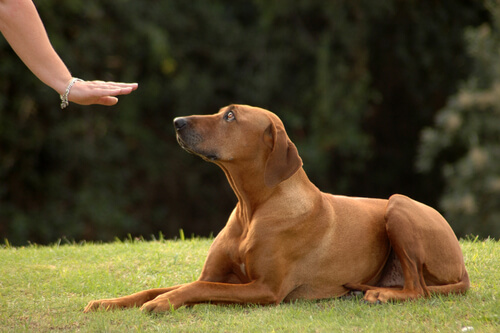Basic Obedience Exercises for Your Dog

Specialists highlight how important basic dog obedience exercises are for your dog’s development of cognitive and social skills.
Fundamentals of obedience in dogs
Obedience is a fundamental part of canine education. And, it can be an essential condition for their training. But, it is necessary to specify that obedience exercises and obedience training are not the same thing.
There are different levels and types of training for animal. Currently, there are three main purposes for dog obedience exercises:
- For dogs that will become service dogs, such as guide dogs, police dogs, rescue dogs, etc.
- Or, for dogs that will compete in competitions or sports
- For domestic and company dogs.

The basic obedience exercises are part of the first level of training a dog. These are general orders, which include “come,” “sit,” “stay,” “quiet,” “here,” and “lay down.”
These commands help educate domestic and professionally trained dogs. The training of a service dog also begins with these basic exercises. In addition, there should be an incentive to play.
Basic obedience exercises: the importance of positive reinforcement
Positive reinforcement means rewarding good behavior. This will stimulate the learning of skills and promote obedience. And, this is especially true in very independent dogs.
To easily teach the basic obedience exercises to your dog, the ideal is to praise and reward him when he executes the required commands correctly. This way the animal can improve his ability to learn and socialize, as well as strengthening his self-confidence.
Offer the reward shortly after the action. This way, the animal will connect it to a specific behavior. So it is best to give your dog his reward immediately as a response to his behavior if you want to reaffirm his behavior positively.
However, it will be necessary to establish certain criteria to avoid unconscious training and create bad habits. This means you need to avoid your dog believing that he can demand a prize for any behavior.
Violence is always counterproductive
The negative -or dominant- method seeks to obtain the desired behaviors by inflicting fear or pain on the animal. Obedience ends up being a compulsory response to a process of physical and emotional wear and tear, and this can cause unfortunate consequences on the welfare and mental health of the animal.
In addition, it has been proven that violence is counterproductive to canine behavior and obedience. Dogs subjected to abuse suffer traumas, which blocks much of their cognitive ability. In addition, the majority of animals trained this way end up developing what is known as “defensive aggressiveness.”
Because of this we insist that the best way to train your dog is to apply positive reinforcement and remove any violent behavior during the training process.
6 tips to teach basic obedience exercises to your dog
1- Commit
It is very important to stay consistent when educating your pet. The animal must become completely used to the commands, which requires commitment and patience on the part of its owner. If the owner does not have the necessary time available, it is best to seek the help of a professional trainer.
2- When to teach
We recommended reserving 10 minutes a day to practice basic obedience exercises with your dog. After all, overloading the animal is counterproductive and causes the animal to become distracted.
3- How to teach
Owners and dogs can work on the basic obedience exercises one by one. This will facilitate the animal’s comprehensive understanding. It is ideal is to spend between three and ten days between the initial presentation of the order and the animal being able to execute it.
How long it takes each animal to learn depends on the animal and the dedication of the trainer. Studies show that some breeds are capable of learning more easily. The Border Collie, for example, learn up to one command per day with proper guidance.

Better positive reinforcement
4- Apply positive reinforcement
Positive reinforcement is always the best option to promote canine obedience. It is always better that our pet performs actions based on a prize, which does not always have to be a treat. It can be petting, games, or other types of praise.
5- Choose the ideal place
To avoid distractions, mainly in puppies, it is important to choose a quiet place to teach your dog. You have to look for a place without many external stimuli, like other dogs, noise, music, food smells, etc.
6- Remember the commands learned
It is essential to spend one or two days a week remembering the basic obedience exercises you have already taught our dog. Otherwise, the animal can forget or confuse commands, which makes teaching new commands difficult.
